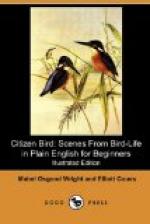“Why don’t we see swarms and swarms of them flying by?” asked Dodo.
“You mean flocks,” said Olive; “we only say ‘swarms’ when we mean bees or other insects.” “They make their journeys mostly by night,” continued the Doctor, “for darkness protects their bright colors from the cannibal birds and various other enemies. One day there will not be a single Warbler in the river woods, and the next the trees will be bright with them.
“Another reason that we do not commonly see these Warblers is, that the greatest number do not come from the South until the trees are in leaf, and they pass back again through the middle portions of the States before the trees are bare in autumn, so that they easily hide from us.”
“Are there no bright-colored birds that live all winter where the trees are bare?” asked Rap.
“Yes, three—the Cardinal, the Crossbill, and the Pine Grosbeak. They are seed-eating birds, and all belong to the Sparrow family. Most of the very showy birds belong to tropical countries, where the trees are always in leaf and there are quantities of orchids and other conspicuous flowers to attract the eye from the birds themselves.
“This habit of travelling by night has caused a great many of these beautiful Warblers to lose their lives, for they often fly against telegraph wires, high steeples, and lighthouse towers, and are killed. Another danger also besets them—they may come from the South with a bit of early mild weather, and nearing the Great Lakes meet a storm from the North, and the food-supply being very scanty, the icy winds overcome their strength.
“A friend of mine who lives in Wisconsin,” continued the Doctor, “has a garden that slopes down to Geneva Lake. Late one April there came a windstorm from the northwest, and the next morning the lawn was strewn with the bodies of hundreds of little Warblers who had become confused in the darkness and unable to reach shelter.
“You see how many troubles and risks Citizen Bird has to endure at best, so that we House People should do everything we can to protect him and make his life among us happy.
“You will have more use for your eyes than your ears, in naming the Warblers. Their plumage is almost always striking, but their voices are rather lisping than musical, though they sing pretty little snatches in the woods; but many of their call-notes sound more like the squeaks and buzzings of insects and tree-toads than like the voices of birds, and it will take time and practice before you can distinguish them apart. I have chosen only half a dozen species to tell you of, from the half-hundred that rove about the United States. The first, and one that you are the most likely to see, is the Black-and-white Warbler.”




